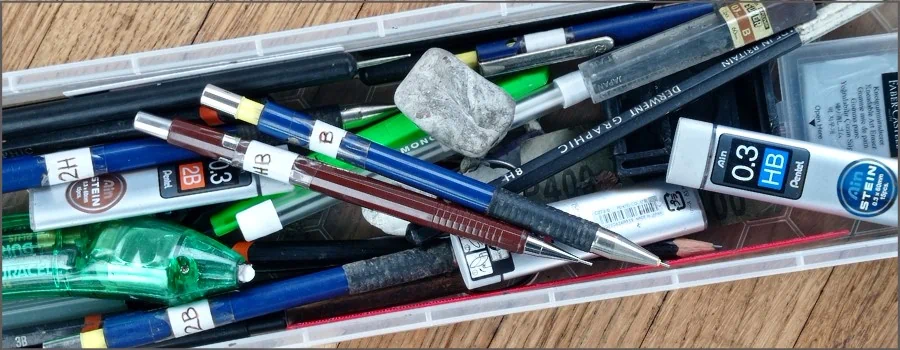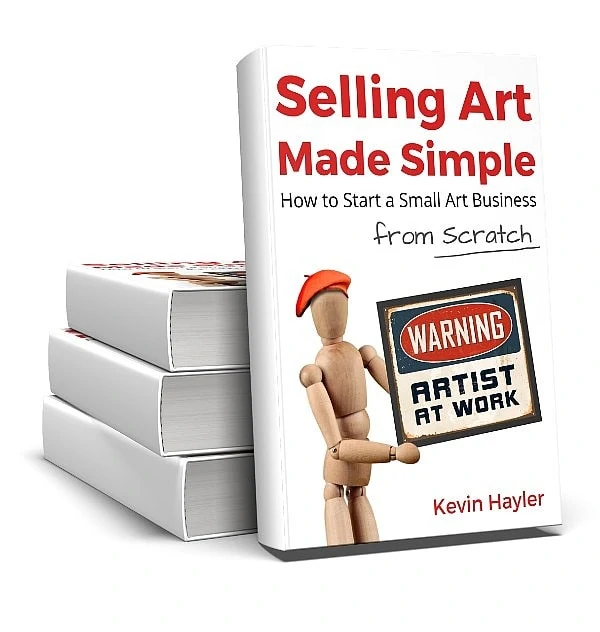Kevin Hayler: Professional Wildlife artist, author, and traveler.
Onlookers are often surprised to see me draw with mechanical pencils, yet I use them all the time. Mechanical pencils are good for drawing, in fact, they are my pencils of choice.
Mechanical pencils are excellent for drawing. The lines erase well, are lightfast, great for precision lines, and perfect for shading. The ‘leads’ range in size from 0.2mm – 0.9mm and are graded from 6H – 4B. The finest grades stay sharp and the thicker grades can be sharpened instantly with emery paper.
Many professional ‘graphite’ artists draw with mechanical pencils but few write about them. That being so, let me tell you why they are so useful and why you should consider using them.
First thing first…
Disclaimer: When you buy something via my affiliate links I earn from qualifying purchases and sometimes earn a commission, at no extra cost to you. I am an Amazon Associate among others. I only recommend trusted sites.
What is a Mechanical Pencil?
Let’s start with the basics, what is a mechanical pencil? That’s not as daft a question as you may think, confusingly, they are known by different names.
Mechanical pencils are also known as:
- Propelling Pencils
- Technical Pencils
- Clutch Pencils
- Drafting Pencils
Essentially, they’re all the same thing. They look like pens and all have thin lead inserts held in place with a clamp-like mechanism.
If there is any difference worth noting, clutch pencils tend to hold thicker leads whilst mechanical pencils propel leads forward and are often much finer.

How to Shade With Mechanical Pencils
It takes time and patience to draw with mechanical pencils. You have to get used to them. The finer leads snap easily and require a light touch. It can be frustrating until you learn how to apply the right pressure.
There’s another knack that needs mastering. An even line must be applied at a constant angle. Even the thinnest lead wears down at a chamfer and the tilt of the pencil determines the width of the line.
Mechanical pencils are great for drawing shadows: How to Draw Realistic Shadows in Pencil

Even hatching requires a very steady hand but once mastered, it’s possible to create a broad flat tone that’s almost impossible to achieve using traditional pencils. Darks are best rendered by cross-hatching and building up the tone gradually in layers.
Drawing Backgrounds With Mechanical Pencils
You would think that mechanical pencils would be hopeless for solid backgrounds, but that’s not the case. In some ways they are superior.
Let me say from the outset that drawing a solid background tone with a mechanical pencil successfully is a slow process. This isn’t a fast and loose drawing.
First of all, I draw my backgrounds using the smallest gauge, I use 0.3mm leads. It’s counter-intuitive but highly effective if you have the extra patience involved.
Using the smallest gauge enhances the finely mottled grain of the paper. A broader pencil gauge produces a broader and coarser grain. That’s fine if your main drawing is coarser but not for my refined style.

I hatch in one continuous direction, from corner to corner. The hatching must be consistent, even, and smooth, with the pencil, held at a uniform angle. No pressure is required, just a steady hand.
When the first layer is complete, you reverse the direction and cross hatch in the other direction, corner to corner.
I proceed until I reach my desired tone. This might take several layers. I usually begin with an HB or B grade, and later transfer to a 2B. I never start with the softer grade and never press harder to create a dark tone. It doesn’t work.
Be careful not to make your drawing shiny: 9 Ways to Stop Pencil Shine in a Drawing and Save Your Work!
Maintaining the speckled effect requires a light touch. The idea is to maintain the grain throughout. The mottled surface adds depth and sparkle to the ‘black’ and gives it life.
For want of a better word, it makes the drawing ‘ZING’.
I don’t know of any other artist who does this. Most artists block in the background with various blending and smudging techniques. It can look great, but it can also look dull and flat.
I love the sparkle and I can only achieve it with mechanical pencils. It’s almost impossible to do it with the same finesse with traditional wooden pencils.
What Size Lead is Best for Mechanical Pencil Drawing?
Personally, I use 0.3mm mostly, and I use them on fine-grain cartridge paper. My drawings are also quite small. If I drew larger pieces in a sketchier style I would favor 0.5mm pencils. I find 0.3mm gives me ultimate control.
The wider grades are certainly more robust and highlight the grain of the paper. If you love the loose speckled effect go with the wider 0.5mm or 0.7mm. The finer grades are easily broken but have far more finesse.
Most brands promote their 0.5mm pencils. It’s an all-rounder. I use the darkest grades which, unlike 0.3mm leads, go up to 4B.
Let me introduce you to the art of Stephen Bauman. He uses mechanical pencils extensively in his drawings. This guy is a cut above, with his astounding painterly technique. If you want to learn from the best he’s your man.
Stephens course is on Proko, it’s not a cheapy, but you are getting a great teacher who knows what he’s doing. Take a look at least.
Stephen Bauman is a classically trained artist and has a very academic approach to his art. This guy knows his stuff and he’s a very good tutor
Are Mechanical Pencils Good For Sketching?
Mechanical pencils are great for drawing fine, precise lines, but 0.5mm pencils, or above, are perfectly good for sketching in a looser way. The wider gauges will produce bold lines and when a fine line is needed the artist must twist the pencil barrel and draw with the sharpened tip.
With experience, the thickness of the lead can be controlled, and the correct pressure applied, to draw rapidly, and with precision.
There is one major disadvantage when sketching with a mechanical pencil. Unlike a wooden pencil, it’s very difficult to draw using the side of the pencil lead. The leads are not really strong enough to be extended far enough without breaking.
Mechanical Pencils vs Wooden Pencils: Do They Mix?
One difference that may concern some people, is the difference in grey tones between the two types of pencil. Wooden pencils produce much more beautiful light greys. I combine them with the ‘B’ grades of mechanical pencils.
Traditional wooden pencils produce beautiful dark greys but they have a reflective shine. Mechanical leads, by contrast, have a richer, muted, and satin appearance.
The two types of pencils also contrast greatly when they reach the end of use. A mechanical pencil only needs a refill, whereas a wooden pencil is reduced to an awkward stump. Most artists use pencil extenders to prolong their life but they change the balance in your hand.
If the feel, weight, and consistency matter most, mechanical pencils will please you. If on the other hand, you enjoy the smell and moments of reflection as you sharpen wooden pencils, they might appeal more.
There is also a difference when it comes to the leads breaking. Mechanical leads break in use. Wooden pencils tend to break when you sharpen them. On the whole, I’d say wooden pencils are more frustrating. There’s always one that gets shattered and you sharpen it to a stump before it’s usable.
The frustration I have with mechanical pencils is the fragile mechanism. They cannot withstand abuse. I have had many pencils jam after I’ve dropped them.
Both wooden and mechanical pencils have good and bad points.
Do Mechanical Pencils and Wooden Pencils Mix?
They do, but there are caveats. The hard (H) grades blend easily but the soft (B) grades do not.
It’s very hard to draw dark-on-dark using a combination of the two types of pencil. The soft mechanical leads are too waxy and the resulting mix is a dirty smudge.
To find out more about saving your drawings read: How to Protect and Preserve Your Drawings
Can You Draw Realism With a Mechanical Pencil?
I would argue that realism is more easily attained using mechanical pencils. Each width and tone requires a change of pencil as a considered and deliberate act. That might appear overwhelming at first but offers an artist a tremendous degree of control.
The lines are uniform and consistent and there’s no need to adjust the pressure to tweak the value or constantly sharpen the lead. And it’s because the pressure is less important than choosing the correct pencil, the lead is applied more delicately, and erased more easily.
Conventional pencils, especially the softer grades, are great for sketching, they encourage a looser style. Mechanical pencils, by contrast, encourage a tighter style. A skilled draughtsman can use both tools either way but it’s easier to refine a drawing with mechanical pencils, that’s if super-realism is your aim.
Put simply, they are made for precision drawing.

There are hidden tricks to make a drawing look good, go to How to Make Your Drawings More Interesting
How to Choose The Best Mechanical Pencils
Your main concern should be the range of leads and their availability. Then there is the pencil itself, they are not so cheap, indeed, some are bloody expensive.
I use Pentel Mechanical Pencils and mix the Hi-Polymer and Ain Stein leads. The latter is supposedly a stronger version of the former which is probably why you can get 0.3mm leads up to 2B.
When I first experimented with mechanical pencils I chose Pentel leads because they were readily available and they had a cheaper range of pencil holders. Nowadays, it’s harder to find good supplies on the shelf and I use online stores.
That’s not to say that replacements are easy to find online. That is not experience. More grades of Pentel leads are available than advertised on Pentel’s own site! It’s more than confusing.
The problem with switching brands is the grading system, it’s not universal. Each company has its own grading formula and I’m used to Pentel pencils which is why I persevere.
These are links to each brand on Amazon:
| Lead Refills | Pentel | Faber-Castell | Staedtler Mars |
| 0.2mm | HB, B, 2B | ||
| 0.3mm | 2H, B, H, HB | 2H, H, HB | |
| 0.35mm | 2H, H, HB, B | ||
| 0.5mm | 2H, H, HB, B, 2B, 3B 4B | 2H, H, HB, B | 3H, 2H, H, F, HB, B, 2B |
| 0.7mm | H, HB, B, 2B | 2H, H, HB, B, 2B | 2H, H, HB, B, 2B |
| 0.9mm | HB, B, 2B | B, HB | |
| 1mm | HB | ||
| 2mm | 4H, 2H, H, HB, B, 2B, 4B |
The major cost involves buying the pencils themselves. You have to buy a separate pencil for each size and grade of lead. That said, compared with other mediums, it’s very little. Once you have the pencil, the refills are cheap.
Top Tip: Label each pencil with the grade to avoid confusion
How to Use Mechanical Pencils
Mechanical pencils work like pens. You simply click the end button to feed out more lead as, and when, it’s needed. Hold the button down and gently push on the lead to retract it. When one lead is finished, continue clicking until the next one appears.
Each pencil gauge requires a different mechanical pencil body and each grade of lead needs a separate pencil too. That adds up. I use 4H, 2H, HB, B, and 2B, 0.3mm pencils, so I need 5 mechanical pencil bodies.
You need another set of pencils to use 0.5mm pencils and so on. Personally, I own a full set of pencils for each gauge of 0.3, 0.5, and 0.7mm leads but I mainly use the 0.3s.
You may decide on a different range, you can easily ditch 4H and 2H and replace them with normal pencils.
Originally, I bought the cheaper ‘120 A3’ Pentel pencils, then the slightly more expensive ‘P200’ model, that’s less prone to jamming. I also like to use Staedtler Mars Micro Pencils which, as you’d expect from a German brand, are well made, a comfortable weight with a rubberized grip.
All my pencils have a detachable top button and the pencil chamber holds the leads. When one lead is exhausted, the next is supposed to slot into place. This is where it goes wrong. Sometimes, the lead gets stuck.
If the lead breaks off in the pencil nib itself you can only dislodge it with wire. The problem is, the wire is seldom supplied, and you NEED it.

If the wire is supplied, it’s to be found inside the holder and pinned to the underside of the eraser, which is itself beneath the button at the top. If you can’t get one you’ll need to buy some wire, of the right gauge, separately.
Before I finish, it’s worth mentioning how delicate the nibs are. They will not survive much punishment. I work outside and they do not always survive dropping onto a hard surface. The nibs are precision made and any fault will ruin the head. Be aware.
Can You Draw With Mechanical Pencils? Final Thoughts
It is a pleasure to draw with mechanical pencils. They are an essential part of my kit. I love the feel and weight of the pencil, and I love how the lead glides across the surface of the paper. The line is true, easily erased, and requires no effort.
If you have never used them before, I think you will enjoy them. As far as I’m concerned, I love to draw with Pentel Mechanical Pencils. They have been a game-changer for me and I highly recommend them.

If you like the way I draw and want to try things for yourself, this is my basic kit
Discovering mechanical pencils made a big difference to the quality of my work and that attracted even more buyers. If you are serious about selling your art then check out this guide!
If you found this post helpful, you’ll enjoy these too:
- What Do Pencil Numbers Mean? Pencil Shades Explained
- 7 Types of Contour Drawing Explained: Quick and Easy
- Best Drawing Pencils for Beginners: How to Choose (2023)
- What is the Best Type of Pencil to Use With Watercolor?
- Is Drawing From Reference Photos Bad? Are You Cheating?
- What’s the Right Paper for Pencil Drawing? (How to Choose Wisely)
- Repair Damaged Drawing Paper – 8 Ways to Rescue Your Artwork
- How to Scale Up a Drawing in 4 Easy Ways and Save Time
- Can You Copy Art and Sell a Painting of a Painting? I Found Out
- Tracing Art – Is It Good or Bad? When Is Tracing Cheating and Is It Ever OK?
Plus find an ONLINE COURSE that suits you.
PIN IT AND SAVE IT


Hi, I’m Kevin Hayler
I’ve been selling my wildlife art and traveling the world for over 20 years, and if that sounds too good to be true, I’ve done it all without social media, art school, or galleries!
I can show you how to do it. You’ll find a wealth of info on my site, about selling art, drawing tips, lifestyle, reviews, travel, my portfolio, and more. Enjoy





